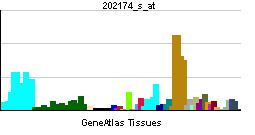Entrez 5108 | Ensembl ENSG00000078674 | |
 | ||
Aliases PCM1, PTC4, RET/PCM-1, pericentriolar material 1 External IDs MGI: 1277958 HomoloGene: 4518 GeneCards: PCM1 | ||
Pericentriolar material 1, also known as PCM1, is a protein which in humans is encoded by the PCM1 gene.
Contents
Function
The PCM1 protein was originally identified by virtue of its distinct cell cycle-dependent association with the centrosome complex and microtubules. The protein appears to associate with the centrosome complex during the cell cycle. Dissociation occurs during mitosis when PCM1 is dispersed throughout the cell. Immunolabeling studies performed found that PCM1 was present in centriolar satellites and in electron dense granules between 70 and 100 nm in diameter. These were originally thought to be scattered only around the centrosomes, but further studies proved that PCM1 was also found throughout the cytoplasm.
PCM1 was shown to be essential for cell division because PCM1 antibodies cause cell-cycle arrest when microinjected into fertilized murine eggs. Targeting of centrin, pericentrin and ninein was also dramatically reduced after PCM1 depletion using siRNA, overexpression of PCM1 deletion mutants and PCM1 antibody microinjection. As a result of this depletion, the radial organization of the microtubules was found to be disrupted, but did not appear to effect microtubule nucleation.
Structure
PCM1 has four known transcripts, the longest of which has 39 exons. The open reading frame of PCM1 encodes a protein of 2024 amino acids. The protein contains coiled coil regions between areas of low complexity as well as an adenosine triphosphate (ATP) / GTPase domain, a nuclear localization domain and a eukaryotic molybdopterin domain. The eukaryotic molybdopterin binding domain is currently found in only five other human genes, xanthine dehydrogenase, sulfite oxidase (mitochondrial precursor), aldehyde oxidase, erythropoietin receptor precursor and the ATPbinding cassette, sub-family A, member 2 (ABCA2).
Tissue distribution
PCM1 mRNA expression in the mouse brain has been found to be highest in the hippocampus. In humans it is expressed above the median level of central nervous system (CNS) expression in most parts of the brain.
Clinical significance
Mutations in the PCM1 gene have been shown to cause genetic susceptibility to schizophrenia. If an isoleucine amino acid change in PCM1 is inherited the risk of developing schizophrenia was found to be 68% in two independent samples from south England and Scotland. This means that it may now be possible to offer very limited genetic counselling to a small proportion of people with schizophrenia who are also carriers of this mutation.
PCM1 forms a complex at the centrosome with disrupted-in-schizophrenia 1 (DISC1) and Bardet-Biedl syndrome 4 protein (BBS4), which provides a link between aberrant PCM1 and the abnormal cortical development associated with the pathology of schizophrenia.
Interactions
PCM1 has been shown to interact with PCNT.
